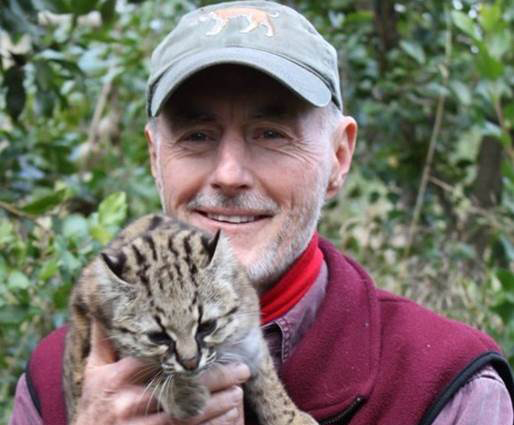Global Wildlife Conservation (GWC) changed its name to Re:wild in 2021
We’re thrilled to introduce GWC’s new program manager of wild cat conservation, Jim Sanderson. Jim’s the founder and director of the Small Wild Cat Conservation Foundation and a member of the IUCN Cat Specialist Group. His mission is clear: to ensure the survival of small wild cats and their natural habitats worldwide. He does so by working with local partners around the world to identify and mitigate threats to the world’s small wild cats.
We had a chance to catch up with Jim about his work and his passion for that work.
Q. How did you develop your passion for small wild cats in particular?
A. As a child I was interested in wildlife and spent a lot of time outdoors. And of all the animals I saw growing up, I will never ever forget the day I saw a bobcat. As an adult I looked at what was being done and where work was needed. The seven big cats got all the attention and funding. Twenty years ago no one was working on the 30 small cats. Anything I did would be new. Moreover it seemed to me the small cats were more shy and even more elusive than big cats. No one goes to Africa to see a Black-footed Cat. All these small cats were waiting for me.
Q. What is your favorite part of the work you do?
A. Being the first to get a picture of a never-before-photographed wild cat, or capturing the first wild cat ever caught is great, but nothing beats the conservation work. I can hand a person who absolutely hated the small cat that was killing all their chickens, they hold it (yes, its drugged, otherwise it would rip us to shreds), and say “It’s the most beautiful cat I have ever seen. He’s got to eat more chickens to put on some weight.” All the hard work is worthwhile. Changing people’s minds to go from killing the cats to respecting them for what they are is what I live for. There is no more satisfying feeling.
 Lunch in Cambodia.
Lunch in Cambodia.
Q. What is your favorite part of field work?
A. Field work on the cats means Christmas every day. This is because the cats are teaching us if we pay attention. Every day I learn something new and different, something I did not realize or think about before. Sometimes it is subtle, sometimes obvious, but always new and interesting:
Q. What is the most rewarding part of the work you do?
A. When I am accompanied by a kid who wants to see the cat. I show them the cat. Twelve years later I visit his parents’ house to say hello. They remember me. They pull out a picture of me and their son. They tell me he is at university studying to be a biologist. Turns out I had no idea I would have such an impact. I had to go for a little walk while I got choked up. And this is just one example. Our conservation not only changes minds, it changes someone’s whole life.

 BACK TO NEWS
BACK TO NEWS